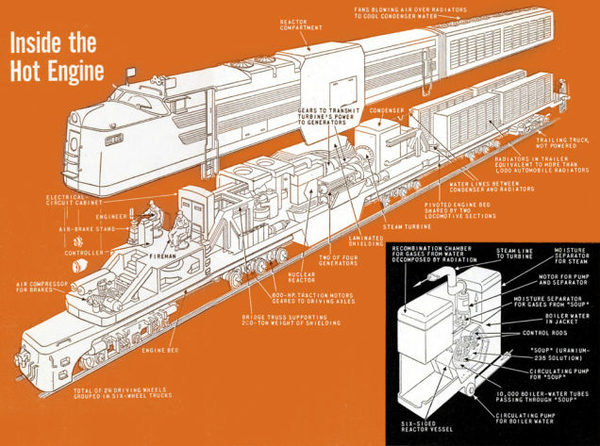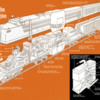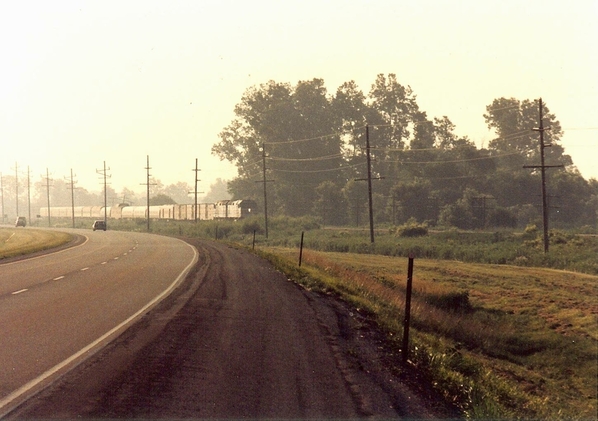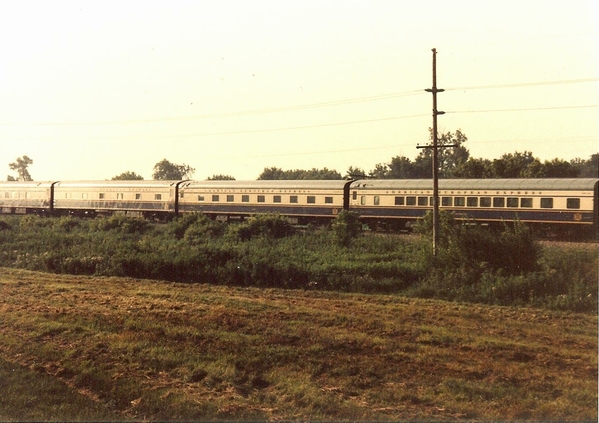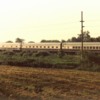By gone are the days of practical rail travel by Steam in the United States. There's definitely footage of revenue passenger steam out there, but there isn't really anything like experiencing it for yourself. I was never alive in the 1950's and the only times I traveled by steam train were for simple excursions on a small mainline. I enjoyed those times, but I've always wanted to experience what it was like to dine and sleep on a trip from L.A. to Chicago back then. I'm aware excursion trains come close to doing this, but they're more of a tourist attraction as opposed to people actually having a motive for going from place to place (going to work, traveling for a vacation, etc.). With the construction of the PRR T1 being done right now, I must ask, will it be possible to arrange for the new engine to travel a complete recreation of the Broadway Limited? I guess I can only dream for now. With such strict regulations in place I'm not sure if something like that could be done without major negotiation. What are your thoughts?
Replies sorted oldest to newest
No. Too much cost involved.
There is barely space in freight schedules for AMTRAK trains. Why do you think there would be room for more passenger trains? John
That's true
Coal as a source of power is very bad indeed for people's heart and lung health. As soon as safer, cost-effective sources of power are available, no one will be using coal because of its health effects. Same goes to a lesser extent for other sources of combustion based energy, although this will take much longer. Thus I think the likelihood of coal or oil fired steam powered locomotives being used except for the occasional excursion is quite remote, simply on the basis of the public health. I know this isn't what people want to hear, but it's unfortunately the scientific and medical facts.
In one word,,,,,,,,,,NO!
Why not?
1) Steam locomotives can only operate a few hundred miles without requiring extensive lubrication, fuel and water. None of which are available at track side anymore.
2) The expense to restore/rebuild those very few remaining main line capable steam locomotives would be prohibitive.
3) There are no longer any craftsmen remaining in the railroad industry capable of maintaining nor operating a steam locomotive at mainline speeds.
4) Since passenger trains are a losing business anyway, the losses would be even greater trying to operate a steam locomotive at current main line track speeds.
5) As mentioned above, the air and ground pollution would NO WAY be tolerated today.
Doubtful. British rail runs regularly scheduled steam engine service (or did until fairly recently), but that is in the context of a state run system and a country that likes that kind of thing,including those running them (for example, that unlike the US, the UK has a huge canal network that is not only maintained, but expanded and reclaimed, for use by canal boaters). While there is obviously a large railfan community, who would run it? Amtrak has serious projects like the Gateway project in NYC, the need to upgrade track it owns, and the obvious issues with shared trackage and how to work with that that they struggle to do. Not to mention that it looks like the current management is not exactly a fan of long distance train service, and it makes it even less likely.
And it is costly, the maintenance on steam engines hasn't gotten any easier than it was when railroads replaced them. Even if we built 'modern day' steam locomotives, they would be extensive to maintain IMO, no matter how much exotic materials we used, modern controls, etc.
Yeah, unlikely they would allow coal fired steam engines and honestly no reason to use that, oil would be the more likely heat source. Given we use oil in diesels, I don't think pollution would be a factor, given how relatively rare such service would be, though obviously modern diesels are pretty clean burning. Unless we totally switch railroads to electrical operation (not likely), pollution wouldn't be a big factor if everything else was doable.
The only way long distance steam train service will happen is if a private operator can figure out a way to make it work, would have to be one stubborn, brilliant, crazy, tough, mean, etc person to get that one done, to get make deals with railroads or amtrak to use their tracks, insurance, getting equipment, and then finding people willing to pay that kind of money and have it where there are enough it could be regularly scheduled (sort of like the modern day Orient Express trains). Given the hurdles and the costs, highly unlikely.
Scheduled passenger trains aren't like excursions. No photo stops or runbys, the windows don't open and vestibules don't have dutch doors anymore.
Once your on a scheduled train for a couple of hours, attention turns inward and the motive power becomes pretty much invisible. The "feel" of riding in a sleeper or eating in a dining car is no different whether a steam or diesel locomotive is on the point.
Rusty
@bigkid posted:Doubtful. British rail runs regularly scheduled steam engine service (or did until fairly recently), but that is in the context of a state run system and a country that likes that kind of thing,including those running them
Last I read, the UK is in the process of "abbolishing" coal as a fuel, and mostall of the operating museums with steam locomotives are scrambling as to how to obtain coal, in the future.
(for example, that unlike the US, the UK has a huge canal network that is not only maintained, but expanded and reclaimed, for use by canal boaters). While there is obviously a large railfan community, who would run it? Amtrak has serious projects like the Gateway project in NYC, the need to upgrade track it owns, and the obvious issues with shared trackage and how to work with that that they struggle to do. Not to mention that it looks like the current management is not exactly a fan of long distance train service, and it makes it even less likely.
And it is costly, the maintenance on steam engines hasn't gotten any easier than it was when railroads replaced them. Even if we built 'modern day' steam locomotives, they would be extensive to maintain IMO, no matter how much exotic materials we used, modern controls, etc.
Yeah, unlikely they would allow coal fired steam engines and honestly no reason to use that, oil would be the more likely heat source. Given we use oil in diesels, I don't think pollution would be a factor,
You are overlooking the fact that a steam locomotive is an "external combustion" machine, and unlike a diesel engine (which of course is an internal combustion machine), the vast majority of the heat generated goes out the exhaust stack! Doesn't matter whether the steam locomotive is burning coal or oil fuel. Also, oil burning steam locomotives do NOT work well for very long, burning #2 diesel fuel.
given how relatively rare such service would be, though obviously modern diesels are pretty clean burning. Unless we totally switch railroads to electrical operation (not likely), pollution wouldn't be a big factor if everything else was doable.
Sorry but, pollution was, and still is, a MAJOR factor with steam locomotives!
The only way long distance steam train service will happen is if a private operator can figure out a way to make it work, would have to be one stubborn, brilliant, crazy, tough, mean, etc person to get that one done, to get make deals with railroads or amtrak to use their tracks, insurance, getting equipment, and then finding people willing to pay that kind of money and have it where there are enough it could be regularly scheduled (sort of like the modern day Orient Express trains). Given the hurdles and the costs, highly unlikely.
Doubtful that anything would ever return whether steam, electric or diesel as many have said already. Also to go on the parts bit about steam engines, although some places can make replacement parts(like Strasburg), there is a bigger problem where parts may be made by playing it by ear. I think one of the documentaries I watched some years ago they did not have original drawings or an original whole piece to go by, so they found something similar to go off of and worked from that(IIRC). Can't remember what locomotive it was they were working on, but if I did I would say so and point you in that direction.
@Hot Water posted:@bigkid posted:Doubtful. British rail runs regularly scheduled steam engine service (or did until fairly recently), but that is in the context of a state run system and a country that likes that kind of thing,including those running them
Last I read, the UK is in the process of "abbolishing" coal as a fuel, and mostall of the operating museums with steam locomotives are scrambling as to how to obtain coal, in the future.
Or facing the prospect of converting all their operational steam locomotives to oil. Chris Eden-Green covers the issue in depth in one of his Gauge The Issue videos:
Rusty
To answer your question - not a chance. In the early 1970s, as a young engineer, I worked for a company that was under contract from the U.S. Government to develop a steam-powered automobile. At the time, efficient, compact, high-pressure (1200 psi) boilers had been developed and the justification was that with such a boiler, a steam engine could produce very low emissions. The problem was that we could not get sufficient efficiency out of the engine itself and the fuel consumption was too high. And, we did not waste energy by exhausting the used steam out the stack, as on a locomotive. To conserve energy, we recycled the exhaust steam in a condenser and reused the water. Steam engines are not as efficient as gasoline and diesel engines, the fundamental reason being that the maximum temperature of the working fluid (steam) cannot approach what occurs during combustion in a gasoline or diesel engine. And the thermal efficiency is directly proportional to the maximum operating temperature of the cycle. Another significant problem was that high-temperature steam literally washed the lubricating oil off the cylinders which led to high ring wear and coking of the rings. So - no - steam engines were practical a hundred years ago. But not today. We did enjoy working with some British steam engine experts on the project… They sure knew a lot about steam engines.
MELGAR
Great post, brings me back the wonderful days of thermodynamics. I seem to recall a steam locomotive was around 40% (a steam turbine is more efficient, closer to 50%), and a gas engine was near 70, whereas a diesel was somewhere in the mid 50's roughly (and it has been a long time), the otto engine is significantly more efficient than a diesel.
If they did go to steam for some reason, I would assume it would be a turbine, not the standard reciprocating steam locomotive of the past . The only places where steam lasted was in places where oil was problematic. South Africa during the Apartheid era ran coal powered steam because they were embargoed and they had coal, not oil. Same with China when they were industrializing, they had plentiful coal and didn't have the supply of oil . Given the world as we have it today, that is pretty doubtful, given the way things are breaking, not exactly a dearth of oil and the trend is slowly but steadily moving away from even oil. The pollution could be deal with, in theory a steam engine could run off something like CNG (wonder if anyone ever tried that? I suspect it wouldn't have the range to be practical, though) or even compressed hydrogen, but again not practical for so many other reasons.
@bigkid posted:Great post, brings me back the wonderful days of thermodynamics. I seem to recall a steam locomotive was around 40% (a steam turbine is more efficient, closer to 50%), and a gas engine was near 70, whereas a diesel was somewhere in the mid 50's roughly (and it has been a long time), the otto engine is significantly more efficient than a diesel.
Don't know where you got your efficiency numbers but, the best, most modern steam locomotive from the 1940s was barely 10% officiant at the rail, while the early EMD FT diesel units were over 50% efficient at the rail.
If they did go to steam for some reason, I would assume it would be a turbine, not the standard reciprocating steam locomotive of the past . The only places where steam lasted was in places where oil was problematic. South Africa during the Apartheid era ran coal powered steam because they were embargoed and they had coal, not oil. Same with China when they were industrializing, they had plentiful coal and didn't have the supply of oil . Given the world as we have it today, that is pretty doubtful, given the way things are breaking, not exactly a dearth of oil and the trend is slowly but steadily moving away from even oil. The pollution could be deal with, in theory a steam engine could run off something like CNG (wonder if anyone ever tried that? I suspect it wouldn't have the range to be practical, though) or even compressed hydrogen, but again not practical for so many other reasons.
You'll see steam powered scheduled passenger service about the same time the SS United States again makes scheduled crossings of the Atlantic Ocean. John
Back in the mid-eighties A few of us rode a deadhead move, behind 765, from Youngstown to Buffalo. Mainline steam, chugging, steam-whistles, cinders, smoke, the whole steam experience... you know who was at the throttle! WOW!
Four trips over two weekends from Buffalo to Corning, and return followed. Definitely main line steam. Nickel Plate 765, with our favorite Engineer at the throttle, gave us one heck of a ride and many Great Lifelong Memories.
Thank you Rich.
What about using a small nuclear reactor to heat the water? I know crazy. ![]()
@Greg - Mi posted:What about using a small nuclear reactor to heat the water?
Never knew that there was a "small nuclear reactor".
I know crazy.
Yup.
@Greg - Mi posted:What about using a small nuclear reactor to heat the water? I know crazy.
Oh, yeah... I'm sure online communities would just love to have mobile nuclear reactors rolling through town.![]()
Besides... Been there, went nowhere:
Rusty
Attachments
I could see revenue passenger steam making a come back in the US.
Listening to many news reports on why people take long distance train trips, most of the answers indicate that people are sick of airplane travel. I personally think the way to revitalize long distance train trips would be to make the rides as different from air travel as possible. Most people associate rail travel as a thing of the past, so why not market it that way? Instead of trying to modernize rail travel to match what airlines offer, turn back the clock to the days where rail travel meant comfortable plush seats in heavyweight cars, parlor cars, etc. To really sell the trips, the motive power could be modern diesels under the hood of a classic streamliner body (like the ex-NS F units that had GP-38? motors). This way the fleet would be easier to maintain as parts would be readily available. This could allow steam to make appearances for special publicity events or even maybe a shorter local run that is steam powered on the weekend.
Essentially, the whole idea is to attract people back to rail travel by making it nostalgic and visually attractive. Build excitement behind modern services by operating older looking equipment (keyword: looking). Occasionally operating the trains with steam would draw more attention to the passenger service which could help it be more profitable
I'm wrapping up senior year of college and took a class on engineering entrepreneurship this semester. One of the main ideas is that when you are selling something, you have success when selling an experience not a product. A perfect place to bring back revenue steam service would be to 're-open' the Pennsylvania-Reading Seashore lines. NJT currently offers trains from Philadelphia to Atlantic city, why not operate those with steam? Families with younger kids would be more enticed to riding behind steam to the beach than taking a 'commuter' trip to the beach. The experience that you're selling here? Adding excitement and history to a trip that you would be making anyway. This is the basis of the Grand Canyon railroad, they are essentially offering a revenue passenger service to and from the national park.
Yes, this is very far fetched and yes there would be many kinks in the concept that need to worked out, but there is momentum behind the idea of privatizing rail travel once again. I recently read an article by Bennett Levin (owner of the PRR E8s and former Commissioner of Philadelphia’s Department of Licenses and Inspections) that suggest removing Amtrak from the keystone corridor. https://www.railwayage.com/pas...urgh/?RAchannel=home. Moving away from Amtrak as the only (non-local) rail service may open opportunities for mainline revenue passenger steam.
On the Keystone Corridor, I think Amtrak owns the tracks....Philly to Harrisburg.
@Prr7688 posted:Yeah, I know its much closer to a dream than a reality but if all the details could be worked out, I think that it would make passenger rail more popular than it is now.
Nope. Long distance passenger rail will never be "popular" in the U.S. due to the extreme costs of operating such trains, no matter what the motive power. Unlike the taxpayer supported "high speed" rail service in Europe (which would pretty much fit within the state of Texas), American taxpayers would never stand for such a bloated, expensive system. Remember, there is not a country on planet Earth that makes a profit hauling passengers! Hauling passenger is a tax supported system to help those under privileged people of their society.
@Hot Water posted:Nope. Long distance passenger rail will never be "popular" in the U.S. due to the extreme costs of operating such trains, no matter what the motive power. Unlike the taxpayer supported "high speed" rail service in Europe (which would pretty much fit within the state of Texas), American taxpayers would never stand for such a bloated, expensive system. Remember, there is not a country on planet Earth that makes a profit hauling passengers! Hauling passenger is a tax supported system to help those under privileged people of their society.
True, that's why I chose the phrasing of 'more popular', meaning that it could maybe attract a different segmentation of riders while keeping current ridership. I do understand what you mean about exterior funding keeping overseas rail service alive.
As much as I'd enjoy it; if it made any sense it would be being done already.
@Prr7688 posted:Yeah, I know its much closer to a dream than a reality but if all the details could be worked out, I think that it would make passenger rail more popular than it is now.
If is a very big word. There are a lot of ducks that would have to line up.
The American Orient Express operated luxury train service between 1989 and 2008. It was an expensive ride attached to certain Amtrak trains and the AOE was eventually done in by a recession.
And right now, Amtrak's not allowing anything non-Amtrak (PV's, steam or diesel excursions.)
Rusty
Attachments
@Rusty Traque posted:If is a very big word. There are a lot of ducks that would have to line up.
The American Orient Express operated luxury train service between 1989 and 2008. It was an expensive ride attached to certain Amtrak trains and the AOE was eventually done in by a recession.
And right now, Amtrak's not allowing anything non-Amtrak (PV's, steam or diesel excursions.)
Rusty
We're definitely on the same page. I think my original comment about it was mis-interpreted; I didn't mean to suggest that my idea is feasible but suggest a different direction that passenger rail travel could take which related it back to the topic of steam in passenger service.
@Prr7688 posted:We're definitely on the same page. I think my original comment about it was mis-interpreted; I didn't mean to suggest that my idea is feasible but suggest a different direction that passenger rail travel could take which related it back to the topic of steam in passenger service.
If you want to see steam in passenger service, in the U.S., then go to:
1) The Strasburg Rail Road.
2) The Cumbres and Toltec Scenic Railroad.
3) The Durango and Silverton Railroad.
To name just three 100% steam operations.
@Hot Water posted:If you want to see steam in passenger service, in the U.S., then go to:
1) The Strasburg Rail Road.
2) The Cumbres and Toltec Scenic Railroad.
3) The Durango and Silverton Railroad.
To name just three 100% steam operations.
Of course, but again the topic was talking about the prospect of mainline steam.
@Prr7688 posted:Of course, but again the topic was talking about the prospect of mainline steam.
Such is NOT what the poster's title states. Now, just because the C&TS and D&S railroads happen to be narrow gauge, their lines are surely "main lines" for them, with VERY steep grades (4% on the C&TS)!
Living in California and watching the State's failing attempts at high speed rail, I can't help but wonder if a "Daylight" type service with an 8-hour schedule might not succeed. I'd be first in line for the 3-unit diner (I loved the grill section as a child) and the observation car.
Watching steam helpers assist the Daylight's sleek diesels make the climb over Cuesta while enjoying a milkshake was certainly as close the Heaven as I'll ever get in this life!
@Hot Water posted:Such is NOT what the poster's title states. Now, just because the C&TS and D&S railroads happen to be narrow gauge, their lines are surely "main lines" for them, with VERY steep grades (4% on the C&TS)!
Why does it seem like you need to make every discussion that you join into an argument? There is a very implicit tone surrounding the term 'mainline' that is upheld in the first post of the discussion. Try to make a conversation out of topics rather than nit-picking every detail and being a constant downer.
@Prr7688 posted:Why does it seem like you need to make every discussion that you join into an argument? There is a very implicit tone surrounding the term 'mainline' that is upheld in the first post of the discussion. Try to make a conversation out of topics rather than nit-picking every detail and being a constant downer.
Believe me "young one", I have worked in the business of main line steam locomotives for more than 50 years, and I know what can, and can NOT be done, in todays era of modern high tech railroading (think PTC and PSR).
Late to the party.
Very simply put the finest passenger steamers are (for the most part) scrapped, and their consists are obsolete. You might as well ask if there will ever be a return of the '40 Ford Coupe. As much as it pains me to say this, NO.
Trains are a business. Decisions are not made from the heart.
@Hot Water posted:Believe me "young one", I have worked in the business of main line steam locomotives for more than 50 years, and I know what can, and can NOT be done, in todays era of modern high tech railroading (think PTC and PSR).
Listen. I'm not doubting or attacking your experience on the topic, but the way you reply to people: it comes off very aggressive. Especially the way you nit-picked when I used the term 'mainline'. I appreciate the knowledge and insight you bring to the forum, but its seems like you are trying to turn post into arguments rather than discussions. I don't want to go back-and-forth with you about this; take a step back and see the way your post come off.
OK guys.....play nice...... Seems that the Real Trains discussions often get way too emotional and personal....lets just take a deep breath....![]()
A compressed natural gas-powered ACE 3000? Naah....still a maintenance headache with all that reciprocating gear. The steam turbine-condenser setup has been tried and abandoned, and the mail-carrying contracts are long gone. I love steam power but there's a reason it's gone - overbearing, horrendous maintenance, fuel and efficiency costs. Look up L.D. Porta and Andre Chapelon, whose work found its way into the suspended British 5AT steam locomotive proposal. That's about as close as you'll get, but it's a little light for American transcontinental work.
https://en.wikipedia.org/wiki/...ogy_Steam_Locomotive
https://web.archive.org/web/20...18/http://5at.co.uk/
I'm actually kind of surprised that this topic was even brought up. It's almost non-sensical, regardless of any modern updates that could be done. It's sort of like asking, "Will the Model T Ford ever be brought back into wide-scale usage?" or, "Will the typewriter ever make a comeback?"
@smd4 posted:I'm actually kind of surprised that this topic was even brought up. It's almost non-sensical, regardless of any modern updates that could be done. It's sort of like asking, "Will the Model T Ford ever be brought back into wide-scale usage?" or, "Will the typewriter ever make a comeback?"
I don't think the point of the OP was to seriously have steam engines take over revenue service from Diesels and the like. The question was more wistful speculation, asking if there is any way there could be some form of regularly scheduled steam passenger service and people discussed it in that light. What is more perfect than on a forum dedicated to one kind of fantasy, the miniature trains we love, to talk about a somewhat fantasy scenario in the real one?
Would a discussion like this be worthwhile in the board room of UP? Nope. Would it be worthwhile if a group of the UP steam team has a couple of drinks in them after a team dinner and throws this idea around after lubrication? Sure, because it is fun, leisure time stuff, with absolutely no impact to the real world. Same here, a bunch of (mostly older) train nuts kicking this around is a leisure time activity, even if we came to some sort of conclusion it was possible, it would stay right here *smile*. So why not kick it around? Okay, a nuclear powered steam engine, while a kind of intriguing form of steam punk, is out there, but it is still fun.
A question for several of the posters to this thread: "What color is the sky in your world?"
Here on Earth it's blue.
The 707 and the DC8 killed te long haul cruise train before 1960. People today are too restless to sit and enjoy the ride.
Plus, I do not think people would ride the thing for a while even with a CV19 vaccine. Why? People will not have the money for travel of any sort for a while. If the Fed Reserve message this AM comes true.
On the operations side, another issue is water. If has to be just right. Or treated so it is just right. Example: UP 844. (Putting on Nomex suit....)




